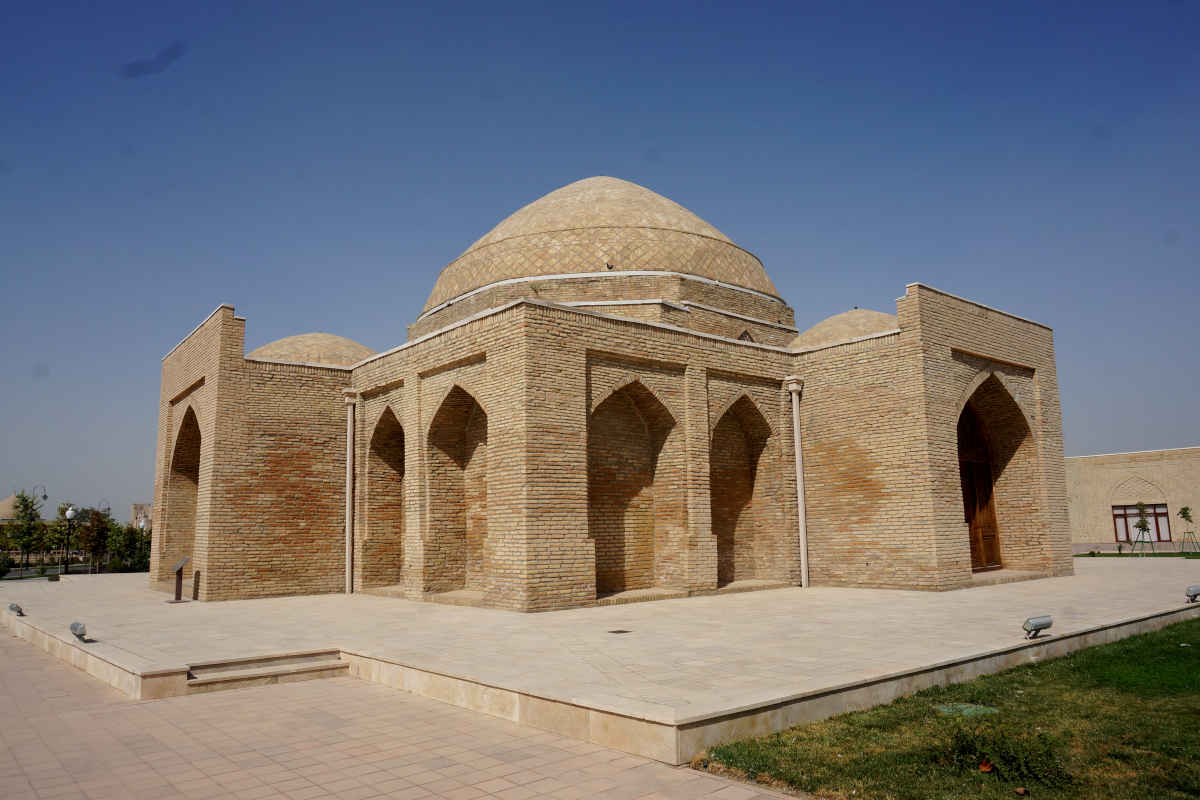Shakhrisabz - Chorsu bazaar

The covered Chorsu Bazaar in Shakhrisabz – a masterpiece of Central Asian commercial architecture
Shahrisabz, one of the oldest cities in Uzbekistan, was an important centre of trade and crafts for centuries. Over the course of history, numerous bazaars, caravanserais and market halls were built here, reflecting the region’s flourishing trade. However, only one of these historic buildings has stood the test of time and has been preserved to this day: the covered bazaar Chorsu, built in 1602.
The meaning of the term “Chorsu” and its strategic location
The name ‘Chorsu’, which literally means ‘four streams’, was a traditional name in Central Asia for bazaars located at the crossroads of important trade routes. The strategic location of the Chorsu bazaar in Shahrisabz was no coincidence: it was built in the heart of the city, right at the crossroads of the region’s most important trade routes.
- One of these roads began at the southern city gate of Charimgar, which was known as the ‘Gate of Termez’ under Amir Temur.
- The other was the east-west trade route, which ran through Shahrisabz and connected the city with other important trading centres.
This convenient location made the Chorsu Bazaar a central hub for traders and travellers for centuries. Valuable goods from all over Central Asia were traded here – from fine silks and ornately embroidered textiles to exquisite ceramics and carpets.
A bathhouse (hammam) was also built right next to the bazaar and is still in use today. This underlines the great infrastructural importance of this area, as the combination of market hall and bathhouse was typical of the economic and social centres of the Orient.
Architectural features – uniqueness compared to other bazaars in Central Asia
Although the basic structure of the Chorsu Bazaar is similar to the medieval trading domes of Bukhara and Samarkand, it differs from other Central Asian bazaars in several architectural details.
Central structure and construction
The centrepiece of the bazaar is a large, roofed main hall with a diameter of 21 metres. The building was constructed with an ingenious four-sided access system:
- Four monumental portals, precisely aligned with the cardinal points, provide access to the interior of the building.
- The central hall is surrounded by a square floor plan with bevelled corners.
- Narrow corridors lead from the main hall to eight smaller side rooms, which originally served as storage rooms and sales outlets.
The dome-shaped main roof, which rests on vaulted sails, is particularly impressive. This architectural technique gives the interior an impressive height and at the same time ensures natural air circulation and even light distribution.
In addition, the smaller side rooms have their own domes, giving the overall appearance of the building a harmonious symmetry.
Masterful brick architecture instead of ornate majolica
While many prestigious buildings in Central Asia are known for their ornate majolica and mosaic decorations, the architects of the Chorsu Bazaar opted for a different aesthetic:
- Instead of elaborate ornamentation, the building impresses with its masterful brick architecture.
- Particularly noteworthy is the skilfully designed brickwork of the shield-shaped herringbone sails, which not only has a load-bearing function but also has an aesthetic effect.
This deliberate restraint in the decoration underlines the functional elegance of the building, which primarily served as a trading centre and not as a magnificent representative building.
Commercial life in the Chorsu Bazaar – a centre of economic exchange
For centuries, the Chorsu Bazaar was the beating economic heart of Shahrisabz. The individual shops within the bazaar specialised in certain groups of goods:
- Ceramics and pottery: Ornate vessels and plates, often decorated with floral and geometric patterns.
- Hand embroidery: Shahrisabz was particularly famous for its ornate suzani embroidery, which is still prized today for its intricate patterns.
- Silk fabrics and carpets: High-quality textiles from local workshops as well as exclusive imported goods from China and Persia.
- Spices and dried fruit: A rich selection of oriental spices, nuts and dried fruit brought to Shahrisabz by traders from all over the Orient.
The bazaar was not only a place of trade, but also a centre of social interaction. People from different regions met here, exchanged news and conducted business negotiations.
The Chorsu Bazaar as a symbol of the Timurid and Sheibanid period
The Chorsu Bazaar is one of the few surviving examples of commercial architecture from the late Timurid and early Sheibanid periods. It represents the economic heyday of Shahrisabz and illustrates the importance of the city as a trading centre on the Silk Road.
Restoration measures and current significance
Although the Chorsu Bazaar is more than 400 years old, it has survived the centuries remarkably well. Various restoration measures have been carried out in recent years in order to maintain the structure and preserve the history of this unique building.
- The load-bearing capacity of the dome was checked and reinforced in some places.
- The historic brick structure was carefully cleaned and restored to preserve the original character of the building.
- The surrounding areas were modernised to make the Chorsu Bazaar more accessible as a tourist attraction.
Today, the Chorsu Bazaar is not only an important architectural monument, but also a popular meeting place for locals and visitors, who can experience the atmosphere of a traditional oriental market here.
The covered Chorsu Bazaar in Shahrisabz is much more than just a historical trading centre – it is a living monument to the city’s rich history.
Its unique architecture, masterful brick construction and former function as an economic centre make it an indispensable part of Central Asia’s cultural heritage.
For travellers who want to experience the authentic atmosphere of a medieval oriental bazaar, the Chorsu Bazaar is an unmissable destination and a window into the past of a city that was once a major crossroads on the legendary Silk Road.
